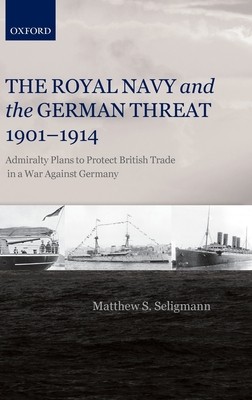
- We will send in 10–14 business days.
- Author: Matthew S Seligmann
- Publisher: Oxford University Press, USA
- ISBN-10: 0199574030
- ISBN-13: 9780199574032
- Format: 16.3 x 23.4 x 2.3 cm, kieti viršeliai
- Language: English
- SAVE -10% with code: EXTRA
The Royal Navy and the German Threat 1901-1914 (e-book) (used book) | bookbook.eu
Reviews
Description
When and why did the Royal Navy come to view the expansion of German maritime power as a threat to British maritime security? Contrary to current thinking, Matthew S. Seligmann argues that Germany emerged as a major threat at the outset of the twentieth century, not because of its growing battle fleet, but because the British Admiralty (rightly) believed that Germany's naval planners intended to arm their country's fast merchant vessels in wartime and send them out to attack British trade in the manner of the privateers of old. This threat to British seaborne commerce was so serious that the leadership of the Royal Navy spent twelve years trying to work out how best to counter it. Ever more elaborate measures were devised to this end. These included building 'fighting liners' to run down the German ones; devising a specialized warship, the battle cruiser, as a weapon of trade defence; attempting to change international law to prohibit the conversion of merchant vessels into
warships on the high seas; establishing a global intelligence network to monitor German shipping movements; and, finally, the arming of British merchant vessels in self-defence.
EXTRA 10 % discount with code: EXTRA
The promotion ends in 22d.21:59:26
The discount code is valid when purchasing from 10 €. Discounts do not stack.
- Author: Matthew S Seligmann
- Publisher: Oxford University Press, USA
- ISBN-10: 0199574030
- ISBN-13: 9780199574032
- Format: 16.3 x 23.4 x 2.3 cm, kieti viršeliai
- Language: English English
When and why did the Royal Navy come to view the expansion of German maritime power as a threat to British maritime security? Contrary to current thinking, Matthew S. Seligmann argues that Germany emerged as a major threat at the outset of the twentieth century, not because of its growing battle fleet, but because the British Admiralty (rightly) believed that Germany's naval planners intended to arm their country's fast merchant vessels in wartime and send them out to attack British trade in the manner of the privateers of old. This threat to British seaborne commerce was so serious that the leadership of the Royal Navy spent twelve years trying to work out how best to counter it. Ever more elaborate measures were devised to this end. These included building 'fighting liners' to run down the German ones; devising a specialized warship, the battle cruiser, as a weapon of trade defence; attempting to change international law to prohibit the conversion of merchant vessels into
warships on the high seas; establishing a global intelligence network to monitor German shipping movements; and, finally, the arming of British merchant vessels in self-defence.


Reviews